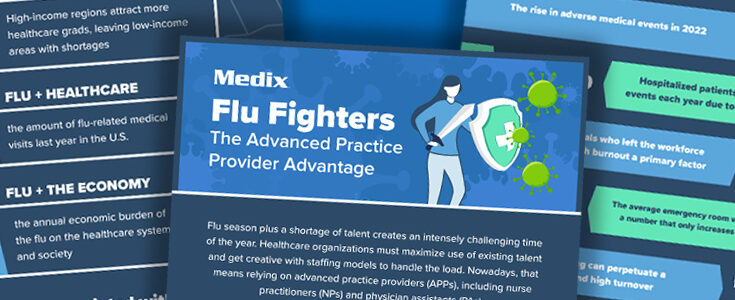How Healthcare Organizations are Using Advanced Practice Providers to Meet Growing Demands

Advanced practice providers (APPs) are having their moment in healthcare. As demand for healthcare services rises in response to aging populations, the prevalence of chronic diseases, and ongoing industry reforms, more and more healthcare organizations are turning to APPs to meet emerging and evolving needs.
All About Advanced Practice Providers
Advanced practice providers is an umbrella term for a range of healthcare professionals who have undergone advanced education and training. APPs include, but are not limited to, nurse practitioners (NPs), physician assistants (PAs), and clinical nurse specialists (CNSs).
These roles initially emerged in the 1960s to supplement physician care, especially in underserved, often rural areas of the country. But as the needs of the population and the healthcare industry evolved, APPs expanded into new areas of practice, including primary and specialty care services, diagnostic evaluations, treatment planning, and even prescriptive authority.
Why We Need APPs
What’s driving the reliance on APPs?
- An aging population: As the global population ages, the incidence of chronic conditions such as diabetes, heart disease, and arthritis has surged. These chronic conditions create a higher demand for continuous and comprehensive healthcare services.
- Shortage of primary care providers: The ongoing shortage of primary care providers, which is expected to continue through at least 2030, particularly in rural and other underserved areas, is well-documented — and there’s no end in sight for this shortfall. APPs help fill this void in care, providing essential services and ensuring patients have timely access to the care they need.
- Healthcare reform and policy changes: Industry reforms such as the Affordable Care Act (ACA) have expanded access to healthcare, increasing the number of insured individuals seeking medical services. This surge in demand has led healthcare providers to rely on APPs to maintain quality and continuity of care.
The Benefits of APPs
For many healthcare organizations, the integration of APPs is no longer a supplemental strategy but a necessity in the wake of growing demands. As Forbes notes, the ACA formally acknowledged PAs and NPs as two of the three categories of primary care providers, along with doctors. Beyond their immediate benefit of filling a void in providers, APPs are valuable to healthcare organizations in a number of ways.
- Enhanced patient access and reduced wait times: APPs increase the availability of healthcare providers, ensuring patients receive care as quickly as possible while reducing the burden on physicians who are already stretched thin. This is particularly beneficial in primary care settings where demand often outstrips supply.
- Cost-effective solution: Employing APPs makes financial sense for healthcare organizations. APPs typically command lower salaries than physicians, reducing operational costs without compromising the quality of care. Many studies support the cost savings, according to Forbes, and the far-reaching implications for every taxpayer.
- High levels of patient satisfaction: Patients just seem to appreciate APPs. In study after study, patients under the care of APPs report high levels of satisfaction. One University of Pittsburgh Medical Center study looking at the impact of APPs at a pediatric urban academic medical center found an increase in patient satisfaction of 10% in just 10 months. APPs often earn high marks for their thoroughness, approachability, and patient-centered care.
- Flexibility in staffing: APPs provide healthcare organizations with flexibility in staffing, enabling them to adjust to fluctuating patient loads and evolving healthcare needs. This adaptability is crucial for responding to peak demand and ensuring continuous patient care.
The Future of APPs in Healthcare
With APPs already providing essential care and enabling healthcare organizations to respond to shortages and demand, the dependence on APPs will likely continue to grow. Three key trends point to an ever-expanding reliance on APPs.
- Growth of APP roles: The Bureau of Labor Statistics projects significant growth in APP employment over the next decade, reflecting their increasing importance in the healthcare system. Nurse practitioners and physician assistants, in fact, are both among the top 10 fastest growing occupations through 2032, with NPs No. 1.
- Technological advancements: Innovations such as telemedicine and electronic health records (EHRs) enhance the capabilities of APPs, enabling them to provide care remotely and efficiently manage patient data. These technologies support the scalability of APP roles in diverse healthcare settings.
- Policy and regulatory developments: Evolving policies and regulations continue to expand the scope of practice for APPs. In addition to the ACA, legislative changes designed to address provider shortages and improve healthcare access are likely to further integrate APPs into mainstream healthcare delivery.
Stakeholders must support the development and integration of APPs to ensure a robust and responsive healthcare system that can meet the challenges of the future.
How To Find APPs for Your Organization
Given the critical ongoing role of APPs — and the increasing demand for them — in today’s healthcare environment, finding skilled APPs is ever more important. Medix is an award-winning leader in healthcare staffing solutions, providing highly qualified APPs quickly and cost-effectively for healthcare providers. With a talent pool of more than 3 million candidates and 20+ years of experience in healthcare, Medix creates staffing strategies tailored to meet the unique needs of its clients. This partnership enables healthcare organizations to optimize patient care delivery while maintaining operational efficiency.

Work with a Trusted Healthcare and Life Sciences Staffing Partner
Connect with Medix to get the expertise and resources you need to succeed.



